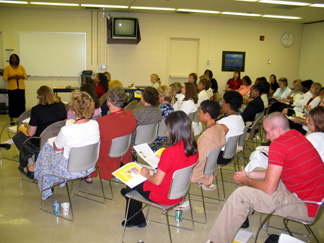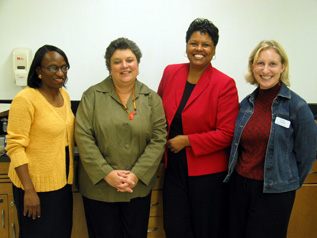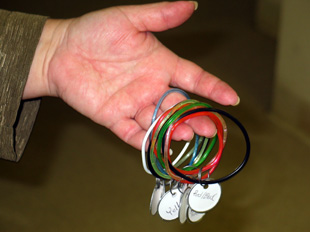 |
Teen sexual behavior is a major concern for all parents. The Sept. 20 audience was one of the largest ever to attend an Employee Diversity Network lunch and learn presentation. Photos by Walter Brooks. |
More than 60 campus staff and faculty members recently received a sobering update on the progressively risky and disease-ridden sexual behaviors of Omaha teens. The Sept. 20 presentation, “Somewhere Not Over the Rainbow: A Fresh Look at Contemporary Teenage Sex and Risky Behavior,” was sponsored by UNMC/The Nebraska Medical Center Employee Diversity Network and Community Partnership and conducted by representatives of the American Red Cross and Planned Parenthood.
The material was designed to give parents and other adults involved with teenagers a street-level view of teen sexual activity and help break down the intergenerational barriers to more effective intervention and communication.
“Based on the volume of comments and questions we received, I am even more certain that we must be more aggressive with adults (parents, grandparents, etc.) to make sure they are aware of the facts regarding HIV and sexually transmitted infections,” said Margie Dumas, HIV/AIDS counselor/trainer for the American Red Cross.
“So often, we feel the school or someone else will provide our beloved children with what they need to know, and that is clearly not the case for too many young people today. We are now in a dangerous race to keep our children safe from sexually, at-risk behaviors. Now is not the time to stick our heads in the sand.”
 |
From left, Margie Dumas, Suzy Prenger, Valda Ford, director, UNMC Community and Multicultural Affairs, and Kate Oelke Turner. Ford, UNMC’s expert on instruction of cultural competency, said cultural competence in intergenerational issues is just as important as it is in racial, ethnic and gender issues. |
“The biggest reason is that there is so little open, realistic communication between adults and teenagers about sex, and it’s playing out on the streets, at parties and in homes while parents are away,” said Kate Oelke Turner, lead educator for Omaha and Council Bluffs, Planned Parenthood of Nebraska and Council Bluffs. “Kids today have far more peer pressure to engage in sexual activity, are constantly bombarded with imagery encouraging sex from advertisements to movies to music videos, and have more unsupervised time on their hands than past generations.”
The result of this convergence of social pressures is that kids today are not only engaging in sexual activity at much younger ages, but their perceptions of what constitutes at-risk behavior is skewed toward disease and health problems.
One shocking revelation among today’s youth, the presenters said, is that they don’t consider oral sex, or even anal sex, as “real” sex. Therefore, girls are more willing to engage in such activities because they feel they are still “virgins.”
The presenters also highlighted two recent social developments among teens: “rainbow parties” and the widespread distribution of sex bracelets.
At rainbow parties, girls each wear a different color lipstick and perform oral sex on a boy, one after the other, until his penis is covered with a series of colored lip impressions. Not only is this placing the entire series of girls at risk for an STD (gonorrhea of the throat is no longer a surprising issue among local infectious disease clinics), but also indicates that public, group sex activity is no longer out of bounds for teens.
 |
Suzy Prenger holds a set of the innocent-looking colored bracelets, which are known among local youth as representing a sexual act. |
“It’s clear that people are interested in these topics from a personal and professional standpoint,” said Suzy Prenger, director of diversity and outreach, Planned Parenthood of Nebraska and Council Bluffs. Among a packet of information, Prenger highlighted a pamphlet titled “Human Sexuality: What Children Need to Know and When They Need to Know It.”
“I wear a large button that says, ‘Ask Me Anything,’ and encourage all parents to do the same,” Prenger said. “As early as possible in our children’s lives, we must give them a sense of confidence that they can come to us to discuss any conceivable sex-related issue and we will never judge them for that.”
“Sexual health and responsibility is everyone’s concern,” Dumas said. “As we continue to see new cases of HIV and STDs in Omaha, we can no longer worry about who is at fault. Rather, we need to help get the message out. Know the facts, ask the questions, and work together. These infections do not discriminate.”
Anyone interested in more information on youth sexual issues or in obtaining handout materials should contact Margie Dumas at 343-7740 (DumasM@usa.redcross.org), Suzy Prenger at 402-441-3329 (suzy.prenger@ppncb.org), or Kate Oelke Turner at 554-1045 (Kate.OelkeTurner@ppncb.org).